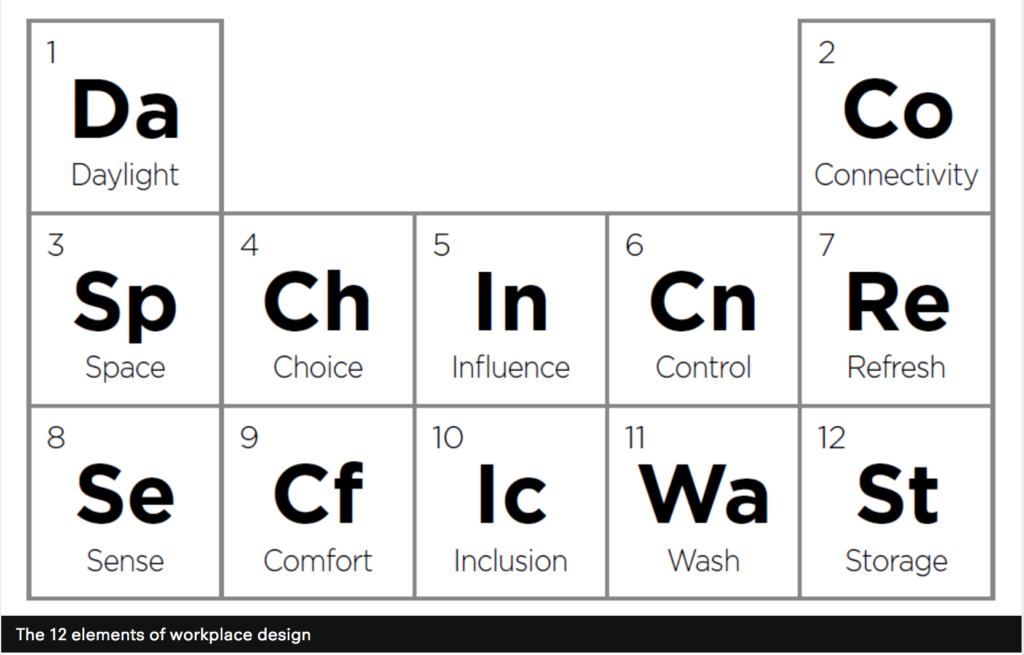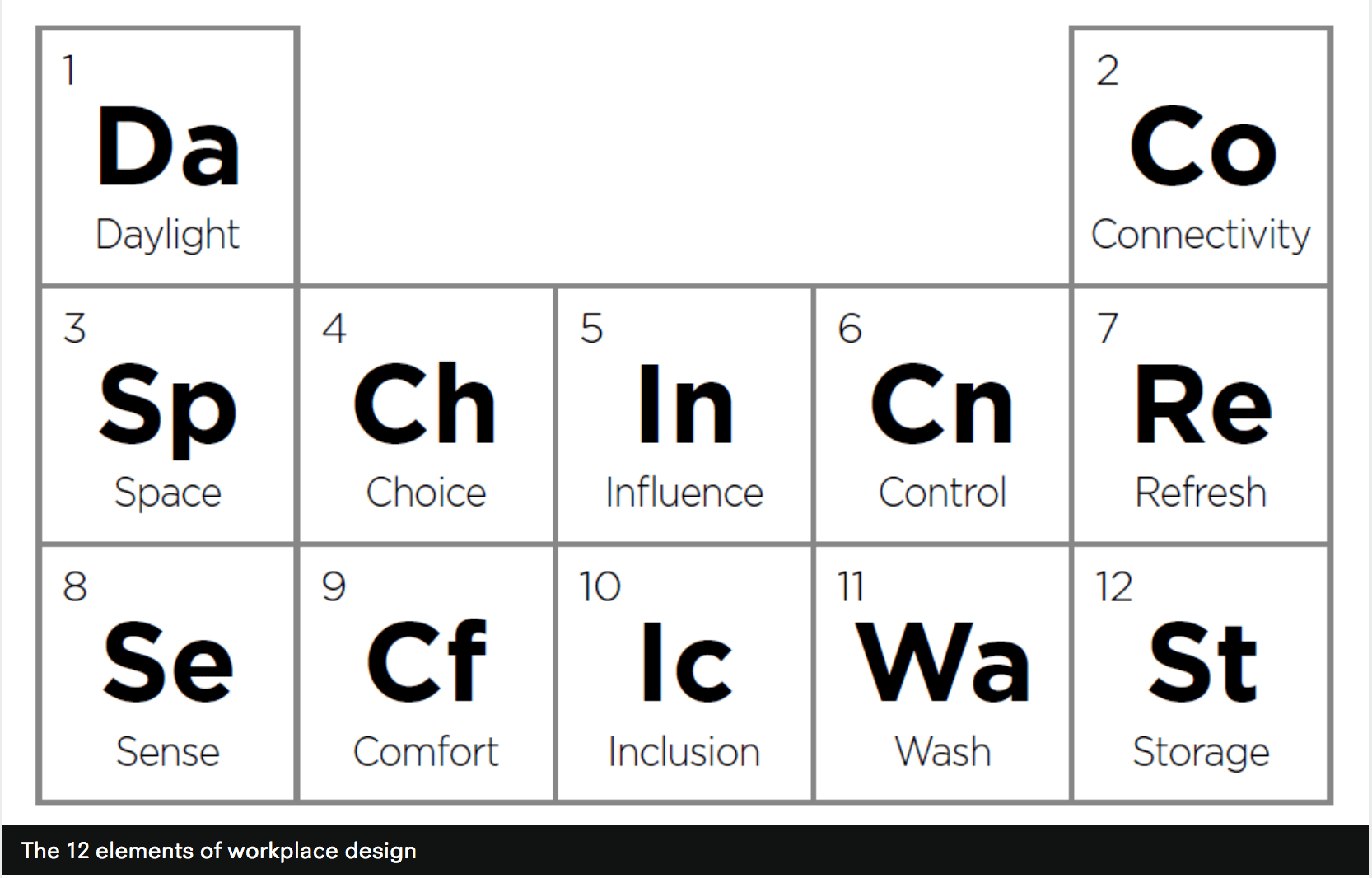Everyone deserves a fantastic workplace that enables meaningful work and enjoyable experiences.
But what does a stimulating workplace look like? How can organisations create an uplifting place for their people to succeed? Neil Usher’s book ” The elemental workplace explores what type of workplace contributes to employees’ sense of self-worth and well-being, and how it benefits organisations too”.

The complexities of workplace design are unpacked and organised into twelve components which we will explore briefly:
Daylight
Daylight is fundamental to everything we’re about as human beings in terms of regulating our circadian rhythms. In this 24/7 world, people think we should do whatever we want, whenever we want.
Daylight reminds us of our essential humanity; according to Usher “we are human animals and should work with nature.”
Connectivity
This is not just about the WiFi and cabled networks, it includes all the kit employees carry and use.
As it is often said today, ‘every business is a technology business’ so Usher suggests fixing the technology before thinking about embarking on a workplace project. He speaks of the ‘social workplace’ within the book, which is the meshing of physical and digital space.
It considers enterprise social networking and how the digital workplace can interweave with the physical space in terms of connecting teams worldwide. Connection, either via enabling spontaneous interactions, building networks, or in terms of creating and sharing knowledge. For Usher, the digital workplace and the physical workplace need to be considered together. It is only when the two are considered together, that a genuine social workspace can be created.
Space
The book argues that it’s important to have sufficient space, but not too much. There is an English expression, ‘not enough space to swing a cat’ and Usher refers to a small experiment that organisations can run to understand this.
It involves a fairly large stuffed toy cat – If a fairly long-tailed toy cat is swung around, it would make a circle that’s about six square metres in area. That’s a useful starting point for thinking about the minimum space that each employee should have on an aggregated basis across the workplace (not at their desk, but on aggregate across the workplace).
Choice
True choice requires the permission to exercise that choice. While many organisations offer a fantastic range of choices, for instance, employee benefits like flexible working, the company culture can lag behind.
“Are you really free to choose to work flexibly if the management culture requires you to sit in the same seat every day, so your manager can make sure you’re working?” Usher asks.
Influence
There is lots of credible research that supports the fact that employees who have been able to influence their space in some way generally perform better and feel better about their working environment.
The influence element is all about the creation of a relationship so that a human being doesn’t feel entirely divorced from the space in which they are working.
Control
People need a degree of control over their immediate environment. Some people have strong feelings about temperature and noise levels, and if they can’t control these elements, they should have the choice to move to a different space.
Refresh
Referring to the noun rather than the verb, there is a growing expectation that the workplace should include appropriate food and drink offerings and include healthy choices as standard.
The ‘refresh’ component also includes having a significant amount of social contribution. It is not just about the physiological contribution of rehydrating yourself or giving yourself enough energy to get through the day, but also ensuring that there is space where people can socially interact.
Today departmental silos mostly get broken down in the social spaces of a workplace, rather than in the working spaces themselves.
Sense
A good workplace should consider, and satisfy, all of our five basic senses. Whilst the refresh element may satisfy taste, there should be a design response, a workplace response, for each sense – sight, smell, touch, and hearing to satisfy.
Textured surfaces and furnishings can satisfy our sense of touch. Whilst some workplaces share a radio or allow music, imagine if incidental sounds were triggered when people moved through social spaces.
The smell is even more emotional; the olfactory sense is linked to the limbic system and so people associate the scent with memories and experiences. Most organisations, if they think about scent at all, aim for a neutral smell – they do not aim for something positive.
Comfort
Whilst most can agree on what is uncomfortable, comfort itself is harder to define. The workplace needs to be designed and arranged with comfort in mind, so that people should never need to remark that the space isn’t comfortable.
Inclusion
Inclusion is a much-discussed topic in terms of making sure that a space responds to the way people are and the way they choose to live. Nobody should be made to feel like a ‘special’ case – the space should easily accommodate everyone’s needs.
Organisations have to continually look at the workplace and audit the design, to ensure it considers all of the potential diversity of their people.
Wash
The quality of workplace toilets is important not just for staff but potential clients and visitors. Washrooms are one of the few spaces that visitors also use. Visitors might use the reception, a meeting room, and probably the toilet before they leave the building or when they arrive. Washrooms say something about the way the company values its staff.
If you want to know whether your company values you or not, go and use the washroom. Too often, washrooms sit outside of the workspace and are regarded as an afterthought.
Storage
Interestingly, with the modern trends featuring workplace well-being, storage is having a renaissance. Whilst many companies are embracing forms of agile working where people can move to the space that best suits them to do the task at hand, there is still a need to store the paraphernalia that employees often bring with them to work such as gym bags, shoes, cycle gear and personal technology. Secure storage is absolutely vital; staff want to lock their valuables away. Buildings thus need to be designed from the inside out.
Sky Central’s campus in West London is a good example of a workplace design that encompasses all of Usher’s 12 elements. Built for three and a half thousand people, over only three floors, it houses a lot of amenities including five cafes and restaurants, and a 200-seat digital cinema. It is also an entirely agile workspace, full of daylight and natural materials. Although it has been designed with a firm, efficient people-space ratio, it feels very spacious.
There is plenty of choices and employees have some sort of individual control and ability to influence their space. There is plenty of storage room as well.
Read our blog on ‘How workplace design affects human behaviour’ to investigate how to create a workplace that benefits employees, in turn yielding better results for businesses long term. To purchase ‘The Elemental Workplace’, click here.
